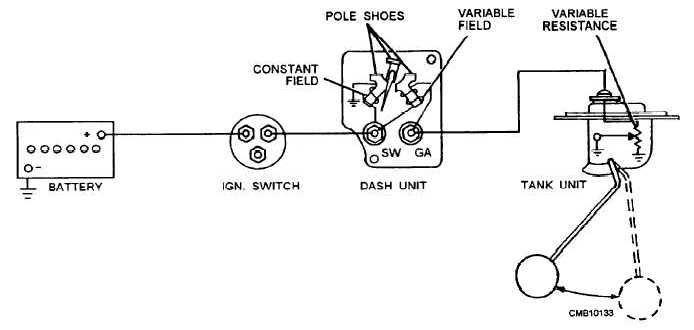Fuel tank baffles are placed inside the tank to prevent the fuel from sloshing or splashing around in the tank. The baffles are metal plates that restrict fuel movement when the vehicle accelerates, decelerates, or turns comers.
Fuel tanks give little or no trouble, and generally require no servicing other than an occasional draining and cleaning.
WARNING
If a fuel tank is punctured or develops leaks, it should NOT be welded or repaired with or near an open flame until all traces of fuel and fuel vapors have been completely removed from the tank. Before attempting to make any repairs to a fuel tank, consult with the shop supervisor for specific instructions on all safety precautions to be observed.
Fuel Gauges
The fuel gauge is a signaling system that indicates the amount of fuel in the tank. Most fuel gauges are composed of two units - the gauge that is mounted on the instrument panel and the sending unit located on the tank
There are two types of gauges - magnetic and thermostatic. Each of these gauges has a sending unit and an instrument panel unit.
1. Magnetic Gauge (fig. 4-4). The sending unit in this fuel gauge contains a sliding contact. As the fuel level in the tank changes, the position of the contact changes on a rheostat winding, varying circuit resistance and resulting current flow. The unit on the instrument panel contains two magnetic coils (limiting coil and operating coil) and a permanent magnet that is attached to the gauge needle. When the fuel tank is empty, the limiting coil is stronger than the operating coil, thus the magnet is drawn toward it and the needle reads EMPTY on the gauge. As the tank is filled, the operating coil becomes stronger, attracting the magnet and moving the needle toward the FULL position.
2. Thermostatic Gauge (fig. 4-5). It has a sending unit similar to the magnetic system. The sending unit has a float and sliding contact that moves on a resistor. As the fuel level in the tank changes, the position of the contact changes on a rheostat winding, varying circuit resistance and resulting current flow. When the fuel is low in the tank, most of the resistance is in the circuit and very little current can flow. As the tank is filled, the float moves up and the sliding contact cuts most of the resistance out of the circuit. This action increases current flow and as the current flows through the heater coil in the gauge on the instrument panel, the current heats the thermostat. The thermostatic blade bends because of the heat. This moves the needle to the FULL mark. As the fuel level in the tank drops, resistance

Figure 4-4. - Magnetic fuel gauge.
Continue Reading